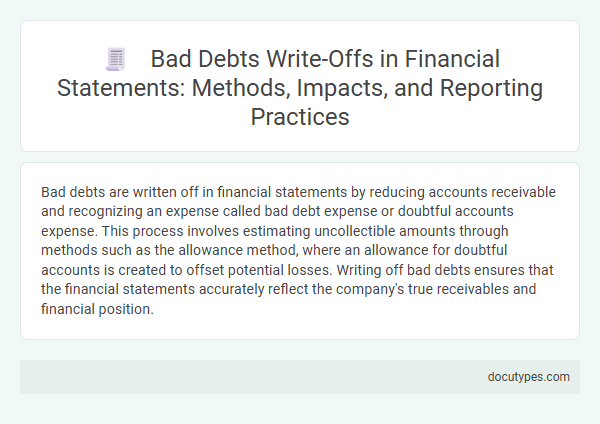Bad debts are written off in financial statements by reducing accounts receivable and recognizing an expense called bad debt expense or doubtful accounts expense. This process involves estimating uncollectible amounts through methods such as the allowance method, where an allowance for doubtful accounts is created to offset potential losses. Writing off bad debts ensures that the financial statements accurately reflect the company's true receivables and financial position.
Introduction to Bad Debts in Financial Statements
Bad debts represent amounts owed to a business that are unlikely to be collected, impacting financial statement accuracy. Understanding how bad debts are recorded helps you maintain precise financial records and manage risk effectively.
- Recognition of Bad Debts - Bad debts are identified when receivables are deemed uncollectible based on customer payment history or financial condition.
- Allowance Method - An estimated amount of bad debts is recorded as an expense and matched against revenues in the same period using an allowance for doubtful accounts.
- Direct Write-Off Method - Specific uncollectible accounts are directly written off as expenses when identified, without prior estimation.
Understanding the Concept of Bad Debt Write-Offs
Bad debts are amounts owed to a company that are no longer collectible and must be removed from the accounts receivable. Writing off bad debts ensures that financial statements accurately reflect the company's financial position by acknowledging these losses.
- Recognition - Bad debt write-offs occur when it is clear that a receivable cannot be collected and is deemed uncollectible.
- Accounting Treatment - The company reduces accounts receivable and records an expense, often under bad debt expense or allowance for doubtful accounts.
- Financial Impact - Writing off bad debts lowers net income and assets, providing a true and fair view of the company's financial health.
Common Methods for Writing Off Bad Debts
Bad debts are written off in financial statements to accurately reflect uncollectible accounts receivable. Common methods for writing off bad debts include the direct write-off method, where specific accounts are removed once deemed uncollectible, and the allowance method, which estimates bad debts using an allowance for doubtful accounts. You should choose the method that aligns with your accounting policies and ensures accurate financial reporting.
Criteria for Recognizing Bad Debts
| Criteria for Recognizing Bad Debts | Description |
|---|---|
| Identifiable Uncollectible Amounts | Bad debts must be clearly identified as amounts that cannot be collected from specific customers, based on evidence such as bankruptcy or prolonged defaults. |
| Historical Collection Experience | Businesses analyze previous collection patterns to estimate and recognize likely bad debts, often using an allowance method based on past data. |
| Ageing of Receivables | Accounts receivable aging schedules highlight overdue balances that are more likely to convert into bad debts; older debts have a higher risk of being uncollectible. |
| Legal Review and Documentation | Legal assessments confirm the status of doubtful accounts. Supporting documents such as court judgments or correspondence are used to justify write-offs. |
| Materiality Threshold | Only bad debts exceeding a materiality level, which impacts financial statement reliability and decision-making, are recognized and written off. |
| Impairment Indicators | Financial indicators including customer insolvency, significant delays in payment, or disputes, signal impairment and justify recognizing bad debt expenses. |
Impact of Bad Debt Write-Offs on Financial Statements
Bad debts are written off in financial statements by removing the uncollectible accounts receivable from the balance sheet and recognizing an expense in the income statement. This write-off reduces total assets and increases expenses, which lowers net income for the reporting period. The allowance for doubtful accounts is adjusted accordingly to reflect the estimated credit loss, ensuring accurate representation of financial health and liquidity.
Reporting Bad Debts: Accounting Standards and Compliance
How are bad debts written off in financial statements according to accounting standards? Bad debts are recognized when receivables are deemed uncollectible, requiring companies to adjust their financial statements to reflect the loss accurately. Compliance with accounting principles such as IFRS and GAAP mandates the use of allowance for doubtful accounts or direct write-off methods to report bad debts.
Bad Debt Allowance vs Direct Write-Off Method
Bad debts are financial losses that occur when a borrower fails to repay a debt, requiring businesses to account for these in their financial statements. Two common methods to write off bad debts are the Allowance Method and the Direct Write-Off Method.
The Allowance Method estimates bad debts in advance, creating an allowance for doubtful accounts as a contra asset on the balance sheet, which matches expenses to the period when sales occur. The Direct Write-Off Method records bad debts only when specific accounts are deemed uncollectible, directly reducing accounts receivable. Your choice between these methods affects how accurately financial statements reflect the company's financial health and compliance with accounting standards like GAAP or IFRS.
Tax Implications of Bad Debt Write-Offs
Bad debts are written off in financial statements by removing uncollectible accounts from accounts receivable, reflecting a more accurate financial position. This process typically involves debiting the bad debt expense account and crediting accounts receivable.
Tax implications arise because bad debt write-offs can reduce taxable income, lowering your overall tax liability. However, the IRS requires specific documentation and proof of debt uncollectibility to claim these deductions on your tax return.
Best Practices for Managing and Reporting Bad Debts
Bad debts are written off in financial statements by recognizing them as an expense, which reduces the accounts receivable balance and impacts net income. This process involves identifying uncollectible accounts through aging analysis and management judgment.
Best practices for managing and reporting bad debts include maintaining detailed records of customer credit history and regularly reviewing receivables for doubtful accounts. Implementing a systematic allowance method ensures accurate reflection of expected losses and compliance with accounting standards.
How Are Bad Debts Written Off in Financial Statements? Infographic

